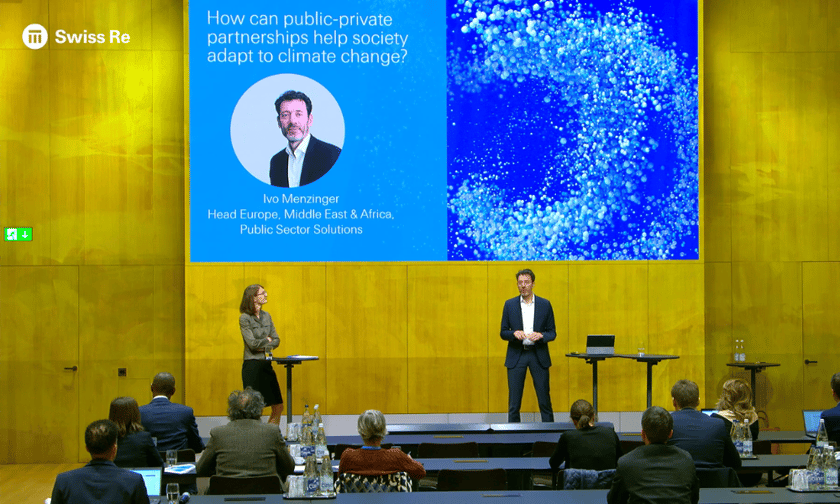

In the latest edition of Swiss Re’s flagship sigma report series, the global reinsurer offered an eye-opening insight into the lay of the natural catastrophe landscape. In 2023, natural catastrophes resulted in economic losses of US$280 billion – of which 40% (US$108 billion) were insured losses, well above the previous 10-year average of US$89 billion.
The report also revealed that, related to GDP, the insurance loss burden from catastrophes has more than doubled over the last 30 years. With such a stark challenge facing the reinsurance and insurance markets, the question on the minds of many is how to keep pace with insuring natural catastrophes as losses keep rising, and how to help society adapt to climate change.
A core component of the answer is to be found in the power of public-private partnerships, according to Ivo Menzinger (pictured), head of EMEA, public sector solutions at Swiss Re during a recent media briefing on the key findings of the report.
He has two clear messages for the market, he said: firstly, that public-private partnerships are key to coping with the risk landscape of today and the future. And secondly, that a comprehensive risk management approach – which includes prevention and risk reduction – is crucial for the market to maintain insurability.
“The latter is a collective responsibility,” he said, “and I would argue that none of the stakeholders involved are good enough at this just yet.”
It’s important to provide clarification around climate mitigation, he said, which in essence is the drive to continue to reduce emissions to counter hazard intensification. However, he noted that as some impacts of climate change are already “locked in”, the industry also needs to invest in climate adaptation to cope with this changing environment.
“There’s a bit of bad news in the sense that climate change is already locked in, so we will have to expect bigger losses, higher losses,” he said. “But there is also an element of good news. There have been previous studies by Swiss Re suggesting that in various jurisdictions and locations, up to 65% of these future losses can be averted cost effectively, which means that the benefit of the avoided damage in the future outweighs the investment required today.”
Menzinger noted that what the sigma report makes very clear is that every stakeholder involved needs to do their part to fund climate adaptation to maintain insurability - including governments, the insurance industry and insureds. What is also clear is, he said, is that “we’re absolutely not there yet.”
What is not a solution to the challenge at hand, however, he said, is mandating insurance companies to assume risk and take it on their balance sheet at non risk adequate prices. You cannot mandate away risk and so, maintaining an open market with the ability to price according to the risk is absolutely key.
What is positive to see is the shift in tone in recent years, said Menzinger who has been working with governments around the world for the last 20 years to help establish new insurance schemes to increase insurance penetration. Recent events, particularly in Europe, have led to a resurgence of these efforts in countries Germany, Italy, Portugal and Greece.
“What I sense is different now is that these conversations about introducing new insurance schemes are not held in isolation,” he said. “From a conversation about how do we reduce risk [it’s become about] how do we prevent risk? And how do we mitigate so the impact of things that we cannot avoid doesn’t become too bad?
“But my main focus is not to tell governments [what they] should do or should not do. I really want to talk about the contribution that the insurance and reinsurance industry can bring to the table. The reinsurance industry really is a gearbox and has a gearbox function in all of this.”
Menzinger highlighted that the insurance and reinsurance industry plays a key role in enabling investments in protective infrastructure by taking out some of the risks involved in building these projects, and helping to make them bankable. When it comes to preparedness and responsiveness, the industry plays a role in incentivising risk reduction through appropriate risk adequate pricing.
The industry also plays a critical role in advising governments and individual policyholders about the risks that they face, he said, and in making sure that the right information is made available to them at the right time. Last, but not least, the industry has a part to play in developing standards of good climate adaption.
Menzinger proposed the need the industry go “back to the future” in terms of how it thinks about solutions for climate mitigation and adaption. The industry is rooted in helping society to manage risk, he said, and, 150 years ago, urban fires were arguably the same challenge for that generation that climate change is to this one.
These fires were widespread and burned entire cities down - in fact, Swiss Re found its roots in the wake of a fire in Switzerland which burned a city down. It took a while, he said, but ultimately, the economic costs of the way buildings were built and where they were built, became so high that the insurance industry and governments had to team up to develop universal underwriting codes for fires and zoning laws.
“I would argue in the context of climate change,” he said, “there may be another need to come together and work jointly on doing what the industry has done before to increase resilience.”
